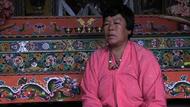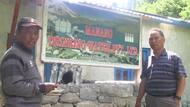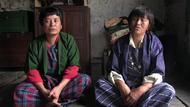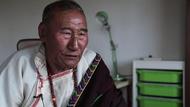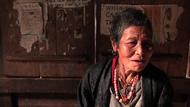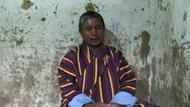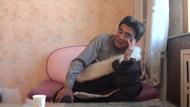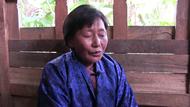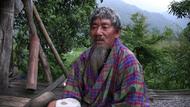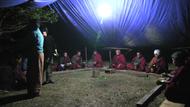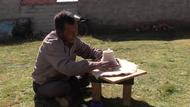Video Overview
Ache Lhamo Cham (dance) in eastern Bhutan was one of the most popular festival events since long ago. According to the oral tradition, the cham dance originated during the time of King Norzang from Tibet, mainly to subdue enemies and local spirits who affected the lives of the people and brought down peace in the region. The dancers in Ache Lhamo Cham represent five members such as King Norzang, his consort, two fishermen and a master called Humley Mebar.
- Chaling
- སྐལ་བཟང་དབང་འདུས Kezang Wangdiའོ་ལགས་སོ། ད་ ང་བཅས་ནང་ བཀྲིས་སྒང་གཤོང་ཕུག་རྒེད་འོག་ བཅའ་གླིང་གཤོང་ཕུག་ཟེར་ གཤོང་ཕུག་བཅའ་གླིང་ཟེར། བཅའ་གླིང་ཟེར་ས་ལུ་ ལྷམ་རོགས་ཀྱིས་ ལོ་རྒྱུས་ཞུ་དགོ་པ་ཅིན་ ད་ དང་པོ་ ཏེ་ ད་ ཨ་ནི་ཱ དང་པོ་གིས་ འཆམ་གྱི་ ཨ་ཞེ་ལྷ་མོ་ཟེར་མི་འདི་ ག་དེ་སྦེ་འབྱུང་ཡི་ཟེར་ན་ ག་དེ་སྦེ་འབྱུང་ཡི་ཟེར་བ་ཅིན་ ཆོས་རྒྱལ་ནོར་བཟང་ཟེར་མི་འདི་དང་ དེ་ལས་ [རྒྱལ་པོ་སྟང་གོས་ཅན་] ཐང་སྟོང་རྒྱལ་པོ་ཟེར་མི་འདི་ ཨ་ནཱི་སྐབས་ལུ་ ཏེ་ འཐོན་ཡི་ཟེར་ཞུ་ནི་ཨིན།Okay. In Shongphu County under Trashigang district and here in Chaling village, I will narrate about Lhamrok or the Azhi Lhamo, which was originated during the time of King Gyelpo Chogyel Norzang and King Gyelpo Tangoechen.
- སྐལ་བཟང་དབང་འདུས Kezang Wangdiད་ ཨ་ནཱི་ཨ་ཞེ་ལྷ་མོ་ གཙོ་བོ་འདི་ ག་དེ་སྦེ་ཨིན་ཟེར་བ་ཅིན་ ད་ འེང་ ཆོས་རྒྱལ་ནོར་བཟང་དང་ ཡབ་ཆེན་ཨ་པ་ཟེར་མི་འདི་ ཨ་ནཱ་འདི་ ག་དེ་སྦེ་ཟེར་བ་ཅིན་ ད་ ཁོ་དང་པོ་ ཨ་ནཱི་ ང་བཅས་ཆོས་རྒྱལ་ནོར་བཟང་འདི་ འཐོན་དགོ་མི་གཙོ་བོ་ར་ ག་དེ་སྦེ་ཟེར་བ་ཅིན་ དང་པོ་ ཏེ་ འེང་ ཕར་བྱང་ལུ་དགྲ་མང་པོ་འཐོན། དགྲ་མང་སུ་འཐོནམ་ད་ལུ་ དགྲ་བཏུལ་ནིའི་དོན་ལུ་ དེ་ལས་ ཏེ་ འཐོན་ཡོདཔ་ཨིན་ཟེར་ཞུ་ནི།The Azhi Lhamtsho is witnessed mainly after the appearance of King Chogyel Norzang and Yabchen Apa. The king Chogyel Norzang has come mainly in order to subdue the enemy in the north.
- སྐལ་བཟང་དབང་འདུས Kezang Wangdiད་ཨིན་རུང་རང་ གཙོ་བོ་ ད་རེས་ནངས་པ་ ད་ ད་རེས་ནངས་པ་ འཆམ་གཙོ་བརྐྱབ་དགོ་མི་འདི་ ག་དེ་སྦེ་ཨིན་ཟེར་བ་ཅིན་ ད་ སྔགས་པ་དང་ ད་ སྔགས་པ་སྔགས་ཆེན་ཟེར་ ཏེ་ སྔགས་པ་ཧུང་ལས་མེ་འབར་ཟེར་ གཅིག་ཡོདཔ་ཨིན་མས། སྔགས་པ་བེ་རུ་ཙན་ཟེར་མི་འདི་ བརྒྱ་ བརྒྱ་གཅིག་ཡོདཔ་ཨིན་མས། སྔགས་པ་བེ་རུ་ཙན་ཟེར་མི་འདི་ སྔགས་ཕྲུག་ཨིན་མས།Today, the drama dance is performed after the appearance of Ngagpa, Ngagchen and Ngagpa Hungley Mabar. There were hundreds of young Ngagpa known as Ngagpa Beratshen.
- སྐལ་བཟང་དབང་འདུས Kezang Wangdiསྔགས་པ་ཧཱུ་ལས་མེ་འབར་ཟེར་མི་འདི་ ཁོ་ཧཱུཾ་ཟེར་བ་ཅིན་ མེ་ཤི་ཤིཔ་དང་ ཕེ་ཟེར་བ་ཅིན་ མེ་འབར་འབརཝ། ཏེ་ སྔགས་པ་ཧཱུཾ་ལས་མེ་འབར་འདི་ གཙོ་བོ་འཐོན་དགོ་མི་འདི་ རྒྱུ་རྐྱེན་འདི་ ག་དེ་སྦེ་སྨོ་ཟེར་བ་ཅིན་ དང་པོ་ འེང་ བྱང་ཕྱོགས་མངའ་ལྡན་རྒྱལ་པོ་དང་ ལྷོ་ཕྱོགས་རིག་ལྡན་རྒྱལ་པོ། ཁོང་གཉིས་མ་འགྲིགས་པའི་ གཙོ་བོ་ལས་བརྟེན་ཏེ་ འབད་ཞིནམ་ལས།Ngagpa Hungley Mabar is an abbreviation of the words, “Hung meaning dead fire and Phey meaning burning of a fire”. The Ngagpa Hungley Mabar has appeared mainly due to the dispute between the north king Jangchog Ngadhen Gyelpo and south king Lhochog Rigdhen Gyelpo.
- སྐལ་བཟང་དབང་འདུས Kezang Wangdiམ་འགྲིགས་དགོ་པའི་དོན་ཚན་འདི་ ག་ཅི་གིས་ཐོག་ཁར་ཨིན་ཟེར་བ་ཅིན་ འེང་ བྱང་ཕྱོགས་མངའ་ལྡན་རྒྱལ་པོ་ཟེར་མི་འདི་དང་ ལྷོ་ཕྱོགས་རིག་ལྡན་རྒྱལ་པོ་ཟེར་མི། ཁོང་གཉིས་འདི་ ཧེ་མ་འདི་ འབངས་མི་སེར་ཡང་འདྲན་འདྲ་ཡོདཔ། འེང་ དེ་ལས་ ཁྲི་ཡང་མཐོ་སྨད་མེད་པར་འདྲན་འདྲ། ཏེ་ དེ་འབདཝ་ད་ དེ་ལས་ ཏེ་ ད་ བྱང་ཕྱོགས་མངའ་ལྡན་རྒྱལ་པོ་འདི་ ཁོ་སེམས་དྲང་པོ་འབད་བཞུགས་པའི་དོན་དག་ལས་ ཁོ་འདི་སྔར་ཤུས་སྔར་ལྡན་འབད་བཞུགསཔ་ད།The northern King Jangchog Ngadhen Gyelpo and the southern king Gyelpo Rigdhen had equal numbers of subjects and status of seats. However, the northern king Gyelpo Ngadhen remained with pure heart and remained as it is.
- སྐལ་བཟང་དབང་འདུས Kezang Wangdiལྷོ་ཕྱོགས་རིག་ལྡན་རྒྱལ་པོ་ཟེར་མི་འདི་གིས་ ག་དེ་སྦེ་ཟེར་བ་ཅིན་ ཁོ་འདི་ ཏེ་ འབངས་མི་སེར་ཡང་ཉུང་སུ་འགྱོ། འེང་ འབངས་མི་སེར་ཡང་ཉུང་སུ་འགྱོ། ཁོ་གིས་ ཁྲི་ཡང་སྨད་ཤོས་སོང་སྟེ། ཁོ་ ཁྲི་སྨད་ཤོས་འགྱོ་དགོ་མི་ གཙོ་བོ་འདི་ ག་དེ་སྦེ་ཨིན་ཟེར་བ་ཅིན་ བྱང་ཕྱོགས་མངའ་ལྡན་རྒྱལ་པོ་གིས་ བང་མཛོད་འདི་ ག་དེ་སྦེ་ཟེར་བ་ཅིན་ ཏེ་ ལྷོ་ཕྱོགས་རིག་ལྡན་རྒྱལ་པོ་གིས་ སྔགས་པ་ཧཱུ་ལས་མེ་འབར་ཟེར་མི་གིས་འབག་འོང་།Ngagpa Hungley Mabar has brought the treasure of the northern king Gyelpo Rigdhen resulting decline in the numbers of people and the status of seat of southern king Gyelpo Rigdhen.
- སྐལ་བཟང་དབང་འདུས Kezang Wangdiདེ་ལས་ མཚོ་ཆེན་པད་མ་ལམ་མཚོ་ཟེར་མི་ མཚོ་འདི་ བྱང་ཕྱོགས་མངའ་ལྡན་རྒྱལ་པོ་གིས་ མཚོ་ནང་གི་མཚོ་གཏེར་བཏོན། དེ་ལས་ ལྷོ་ཕྱོགས་ལུ་ ལྷོ་ཕྱོགས་རྒྱལ་པོའི་འབག་ ལྷོ་ཕྱོགས་རྒྱལ་པོའི་འབག་བའི་ གཙོ་བོ་ལས་བརྟེན་ཏེ་ དེ་ལས་ ཏེ་ ཁོང་གཉིས་མ་འགྲིགས་པར།The northern king Gyelpo Ngadhen had a big lake called as Tshochen Pema Lamtsho. However, the southern king Gyelpo Rigdhen has taken out the treasure and took with him. This was the root cause of dispute between the two kings.
- སྐལ་བཟང་དབང་འདུས Kezang Wangdiདེ་སྦེ་འབདཝ་ད་ལུ་ དེ་ལས་ ད་ལྷོ་ཕྱོགས་རྒྱལ་པོ་གིས་ ཏེ་ ཁོ་ལུ་འདི་ བང་མཛོད་ག་ནི་ཡང་མེདཔ་པའི་གཙོ་བོ་ལས་བརྟེན་ཏེ་ དེ་ལས་ ཕྲག་དོ་ལས་བརྟེན་ཏེ་ དེ་ལས་ ཏེ་ ད་ སྔགས་པ་ཧཱུ་ལས་མེ་འབར་ཟེར་མི་འདི་ ཁོ་འདི་ ཁོ་མཚམས་ལོ་གསུམ་ཆོས་གསུམ་འབད་དེ། ཁོ་མཚམས་བཅད་དེ་བཞུགསཔ་ད་ལུ་ ཁོ་དེ་ལས་ ཏེ་ བྱང་ཕྱོགས་མངའ་ལྡན་རྒྱལ་པོ་ཟེར་མི་འདི་གིས་ དེ་ལས་ ལྷོ་ཕྱོགས་རིག་ལྡན་རྒྱལ་པོ་གིས་ བང་མཛོད་ཕར་ བྱང་ཕྱོགས་མངའ་ལྡན་རྒྱལ་པོའི་བང་མཛོད་འབག་མི་འདི་ཚུ་ ལོག་འབག་འོང་ནིའི་དོན་དག་ལས་ སྔགས་པ་ཧཱུ་ལས་མེ་འབར་འདི་ དེ་བསྒང་འཐོན།The southern king Gyelpo Rigdhen did not have any treasure. So he took it from the northern king Gyelpo Rigdhen out of his jealousy. During this juncture, Ngagpa Hungley Maber, came out of his three years retreat, in order to bring back the treasure of northern king Gyelpo Ngadhen.
- སྐལ་བཟང་དབང་འདུས Kezang Wangdiདེ་ལས་ སྔགས་པ་ཧཱུ་ལས་མེ་འབར་འདི་འཐེན་ཏེ། དེ་ལས་ ཏེ་ བྱང་ཕྱོགས་ བྱང་ཕྱོགས་རྒྱལ་པོ་གིས་ འེང་ མཚོ་ཆེན་པདྨ་ལམ་མཚོ་ཟེར་མི་ མཚོ་འདི་ཁར། སྔགས་པ་ཧཱུ་ལས་མེ་འབར་ཟེར་མི་འདི་གིས་ མཚོ་བཞི་ནང་ ལྕགས་ཕུར་བཞི་གདབ། དེ་ལས་ ཐོག་ཁ་ལས་ཕར་ ལྕགས་ཐག་བཞི་ དམ་པ་དགུ་བརྒྱ་ཟེར་མི་འདི་ ཕར་ཐོག་ཁར་གདབ་སྟེ།Ngagpa Hungley Maeber placed four iron pillars at the lake known as Tshochen Pema Lamtsho. The top of pillars are tied with an iron rope known as Dampa Gubja.
- སྐལ་བཟང་དབང་འདུས Kezang Wangdiདེ་ལས་ ཏེ་ མཐོངམ་ད། དེ་ལས་ ཏེ་ མཚོ་ནང་གི་ མཚོ་གཏེར་ག་ར་ ཏེ་ ད་ ལྷོ་ཕྱོགས་རྒྱལ་པོ་གིས་ཚུར་ལྷོད་དེ། དེ་ལས་ ད་ བྱང་ཕྱོགས་རྒྱལ་པོ་འདི་ ཁྲི་སྨད་ཤོས། འབངས་མི་སེར་ཉུང་སུ་འགྱོ་སྟེ། ཁོ་སྤྱང་ཀ་འཐོནམ་ད་ལུ་ ལྷོ་ཕྱོགས་རིག་ལྡན་རྒྱལ་པོ་གིས་ དེ་ལས་ ཏེ་ ག་ནི་ཡང་ བྱང་ཕྱོགས་རྒྱལ་པོ་གིས་ བང་མཛོད་ག་ར་ ལྷོ་ཕྱོགས་རྒྱལ་པོའི་འབག་སྟེ།They were able to see all the treasures in the lake and took it to the south resulting decline in numbers of subjects and the status of seat of northern king.
- སྐལ་བཟང་དབང་འདུས Kezang Wangdiབྱང་ཕྱོགས་རྒྱལ་པོ་མེདཔ་འཐོན་དགོ་མི་ གཙོ་བོ་ག་ཅི་ཟེར་བ་ཅིན་ ལྷོ་ཕྱོགས་རིག་ལྡན་རྒྱལ་པོ་ཟེར་མི་གིས་ སྔགས་པ་ཧཱུ་ལས་མེ་འབར་གིས་ ཁོ་གིས་བང་མཛོད་ག་ར་འབག་ཡོདཔ་ལས་བརྟེན་ཏེ་ མེདཔ་འགྱོ་མི་འདི་ ཨ་ནཱི་སྦེ་ཨིན་ཟེར། ཏེ་ དེ་ལས་ ཏེ་ ད་ འེང་ ཡར་བྲག་ཕུག་ཀྱིའུ་རི་ཟེར་ས་ལུ་ བླ་མ་དྲང་སྲོང་འབད་སར་སོང་ཏེ། དེ་ལས་ ཞུཝ་ད་ལུ་ ཏེ་ བླ་མ་དྲང་སྲོང་ཡང་ ཏེ་ ད་ བྱང་ ལྷོ་ཕྱགོས་རིག་ལྡན་རྒྱལ་པོ་ཟེར་མི་འདི་ ཁོ་ལུ་ཡང་མཚོ་ཆེན་ ཁོ་ལུ་ པདྨ་ ཁོ་ མཚོ་ ཁོ་ལུ་མཚོ་མེད་ཟེར་ ཏེ།After loosing his status, the northern king, went to see the sage Lama Drangsong at Draphug Kuiri. The sage Lama Drangsong said that the southern king do not have a lake.
- སྐལ་བཟང་དབང་འདུས Kezang Wangdiཁོ་ལུ་འདི་ ལྷ་མཚོ་ ངང་ལག་ཤིང་མེད་པའི་གཙོ་བོ་ལས་བརྟེན། གཙོ་བོ་ར་ བླ་མ་མེདཔ་ལས་བརྟེན་ཏེ་ ཁོ་མར་ཕབ་འགྱོ་མི་འདི་ ཨ་ནཱི་ལས་ཨིན། ད་ ཁོ་འདི་ བྱང་ཕྱོགས་མངའ་ལྡན་རྒྱལ་པོ་གིས་བང་མཛོད་ཚུ་འབག་འོངམ་ད་ ཕྱུགཔོ་འགྱོ། ཕྱུགཔོ་འགྱོ་བའི་ གཙོ་བོ་ལས་བརྟེན་ཏེ་ ལོག་འབག་འོང་ནིའི་དོན་དག་ལུ་ ཏེ་ སྔགས་པ་ཧཱུ་ལས་མེ་འབར་འདི་ ཁོ་མཐུན་གྲོལ་ཏེ་ འཐོན་ཏེ་འབདཝ་ད་ལུ།The southern king’s status has gone down as he did not have a banana tree and lake in the higher place. However, he became rich after bringing the treasures from the north. Ngagpa Hungley Mabar came out of his retreat to bring back the treasures from the south.
- སྐལ་བཟང་དབང་འདུས Kezang Wangdiདེ་ལས་ ཏེ་ འོག་ཕྱོགས་ཀླུ་ཟེརཝ་ད་ལུ་ ཀླུ་ཡི་མཚོ་མོ་ཟེར་མི་འདི་དང་ ཡིད་འཕྲོག་ལྷ་མོ་དང་ མཛེས་ ལྷ་མོ་མཛེས་ལྡན་ཟེར་མི་འདི་ ཁོང་འདི་ཚུ་བཀུག་སྟེ། དེ་ལས་ ཉ་པ་ ཉ་པ་ཉ་རོགས། ད་རེས་ནངས་པ་ ཨ་ཞེ་ལྷ་མོ་ནང་ན་ ཉ་པ་ཉ་རོགས་ཟེར་ འཐོན་དགོ་མི་གཙོ་བོ་ར་ ག་དེ་སྦེ་ཟེར་བ་ཅིན་ བྱང་ཕྱོགས་རྒྱལ་པོའི་ ཏེ་ ད་ འོག་ཕྱོགས་ཀླུ་ཟེར་མི་འདི་ ཏེ་ ད་ ཀླུ་ཡུལ་ལས་ཡར་ ལྷ་མོ་ཀླུ་མོ་ཟེར་མི་འདི་ཚུ་ དེ་བསྒང་འཐོན་ཏེ།Then he called the Female Serpent, Yethro Lhamo and Lhamo Dzedhen. The Nyapa and Nyarok appears in the drama dance of Azhi Lhamo while the Northern king calls the serpent which resided in the lake.
- སྐལ་བཟང་དབང་འདུས Kezang Wangdiལྷ་མོ་ཀླུ་མོ་ཚུ་འཐོན་ཏེ་ དེ་ལས་ ཨ་ནཱ་མཚོ་ཆེན་པད་མ་ལམ་མཚོ་ཟེར་ས་ལུ་ སྔགས་པ་ཧཱུ་ལས་མེ་འབར་ཟེར་མི་འདི་ མཚོ་ནང་དུག མཚོ་ནང་ལུ་ དུག་བླུགས། འེང་ དེ་བསྒང་ ཏེ་ འེང་ སྔགས་པ་བརྒྱ་དང་རྩ་བརྒྱད་འདི་ཚུ་ གཡིབ་བཞག་སྟེ་ དེ་ལས་ ཏེ་ ཨ་ཙི་ཁ་ལས་འབདཝ་ད་ དེ་ལས་ མཚོ་ མཚོ་གི་བདག་པོ་འདི་ འེང་ སྔགས་པ་ འེང་ འོག་ཕྱོགས་ཀླུ་ཨིན་པས།Ngagpa Hungley Mabar poured the poison in the lake of Tshochen Pema lamtsho after calling the Lhamo and Lumo. Then he had hidden 108 Ngagpa. The serpent was the owner of the lake.
- སྐལ་བཟང་དབང་འདུས Kezang Wangdiའོག་ཕྱོགས་ཀླུ་ལས་ ཡར་བཞེངས་ཏེ། དེ་ལས་ ཀླུ་གིས་འཐོནམ་ད་ལུ་ ལྷ་མོ་ཀླུ་མོ་ དེ་བསྒང་འཐོན་ཏེ། དེ་ལས་ ལྷ་མོ་ཀླུ་མོ་གཉིས་འཐོན་ཏེ། དེ་ལས་ ཏེ་ ཉ་པ་སྔོན་པོ་ཟེར་འོང་། སྔོན་པོ་ཟེར་མི་འདི་ དེ་བསྒང་ ཁོ་མཚམས་ནང་སྡོད། ཁོ་ལོང་། ལྷ་མོ་ཀླུ་མོ་གཉིས་ཀྱིས་ ཨ་ནཱི་ ཉ་པ་ཉ་རོགས་ཟེར། ཉ་པ་འདི་ཡར་ལྷོང་། ཉ་པ་ཡར་ལོང་སྟེ། དེ་ལས་ ཏེ་ མཚོ་འདི་སྟེ་ཡོད་མེད་བལྟ། མཚོ་ཆེན་པད་མ་ལམ་མཚོ་སྟོངམ་བཟོ་སྟེ་མེད་པར།Then the serpent known as Lhamo and Lumo came out of the lake. They had Nyapa and Nyarok in which Nyapa came out and found the lake Tshochen Pema Lamtsho empty. After that the Ngapa Nyoenpo came out of his retreat
- སྐལ་བཟང་དབང་འདུས Kezang Wangdiདེ་ལས་ ཏེ་ ལོང་། མཚོ་འདི་ འབདཝ་ད་ལུ་ ཨ་ནཱ་ཉ་པ་ སྔགས་པ་ཧཱུ་ལས་མེ་འབར། ཉ་པ་ཟེར་མི་འདི་བཟུང་ཞིནམ་ལས་ ཁོ་འདི་ ཁྲིམས་བཏངམ་ད་ལུ་ དེ་ལས་ ཏེ་ ཉ་པ་བསད་ནི་འབདཝ་ད་ལུ་ ཉ་པ་མ་བསད་ཟེར་སླབ་སྟེ། དེ་ལས་ ཏེ་ ཉ་པ་འདི་ གསོ་ལེན་འབད་དེ། ཉ་པ་གསོ་ལེན་འབད་དེ་ སྔགས་པ་འདི་ སྔགས་པ་གིས་ ཉ་པ་གིས་ སྔགས་པ་བསད་ནི་འབདཝ་ད་ སྔགས་པ་གསོ་ལེན་འབད་དེ་ སྔགས་པ་བཏང་།Ngagpa Hungley Maber caught the Nyapa and as a penalty he was about to kill. However, after the request he was let free. After that Nyagpa tried to kill Ngagpa who was also let free eventually.
- སྐལ་བཟང་དབང་འདུས Kezang Wangdiདེ་ལས་ ཉ་པ་བཏང་། ཉ་པ་གིས་འབད་དེ་ ལྷ་མོ་ཀླུ་མོ་གཉིས་བཏོན་ཏེ། དེ་ལས་ ཏེ་ མཛེས་ལྡན་ལྷ་མོ་ཟེར་མི་དང་ [རྒྱལ་པོ་སྟང་གོས་ཅན་]ཐང་སྟོང་རྒྱལ་པོ་ཟེར་མི་དང་ ཨ་ནི་ཡུམ་ཆེན་ཨ་མ་ཟེར་མི་ ཡབ་ཆེན་ཨ་པ་ཟེར་མི་ དེ་བསྒང་འཐོན་ཏེ། དེ་ལས་ ཏེ་ ཡབ་ཆེན་ཨ་པ་གིས་འབད་དེ་ བྱང་ཕྱོགས་མངའ་ལྡན་རྒྱལ་པོ་གིས་ ག་ཅི་ལོ་ བང་མཛོད་ ཨ་ནི་ཚུ་ག་ར་ ལོག་སྔར་ཤུས་སྔར་ལྡན་འབད་དེ་ བྱང་ཕྱོགས་མངའ་ལྡན་རྒྱལ་པོ་ལུ་ཕུལ།The Ngapa brought the Lhamo and Lumo. At that time, Dzedhen Lhamo, King Gyelpo Tangpoi Chen, Yumchen Ama and Yapchen Apa appears. Lead by Yapchen Apa, the treasures were handed back as it is, to the northern king Gyelpo Ngadhen
- སྐལ་བཟང་དབང་འདུས Kezang Wangdiཕུལ་ཚར་ཏེ། དེ་ལས་ ཏེ་ ལྷོ་ཕྱོགས་རིག་ལྡན་རྒྱལ་པོ་འདི་ ད་ ཁོ་ག་ནི་ཡང་མེདཔ་འཐོན་ཏེ། ཨ་ནཱི་སྦེ་འབདཝ་ད་ལུ་ ཏེ་ ཉ་པ་གིས་ ཁོ་ ཁོ་གིས་བང་མཛོད་འདི་ག་ར་གནང་ཟེརཝ་ད་ བྱིན་མ་བཏུབ་པར་སྡོདཔ་ད་ལུ་སྟེ། དེ་ལས་ བྱང་ཕྱོགས་མངའ་ལྡན་རྒྱལ་པོ་གིས་ ལྷོ་ཕྱོགས་རིག་ལྡན་རྒྱལ་པོ་ལུ་ འདྲོགས་བཏོན་ད་ལུ། འདྲོགས་བཏོན་དགོ་པའི་དོན་དག་ ག་དེ་སྦེ་ཟེར་བ་ཅིན་ ད་ལྟོ་ ཏེ་ བང་མཛོད་ཚུ་ལོག་འབག་ཤོག་ཟེརཝ་ད་ལུ་ འབད་འོང་མི་བཏུབ་པས།The southern king Gyelpo Rigdhen became poor. However, he did not return all the treasures which forced the northern king to frightened him.
- སྐལ་བཟང་དབང་འདུས Kezang Wangdiད་ལྟོ་ ཁྱོད་ ཏེ་ འབག་འོང་མ་བཏུབ་པ་ཅིན་ཁྱད་མེད། སྔགས་པ་བེ་རུ་ཙན་བརྒྱ་གཅིག་ཡོདཔ་ཨིན། ཨ་ནཱི་འབདཝ་ད་ལུ་ ཏེ་ ཀླུ་ཡི་མཚོ་མོ་ཁྱོད་ ག་དེ་འབད་འོང་ག་ ང་གིས་བལྟ་གེ་ནོ་ཟེརཝ་ད་ལུ། དེ་ལས་ ཀླུ་ཡི་མཚོ་མོ་ཡར་ལོང་སྟེ། དེ་བསྒང་ ནོར་བུ་དགོས་འདོད་དཔུང་འཇོམས་འདི་ དེ་བསྒང་ ཏེ་ གནང་ཡོདཔ་ཨིནམ་པས། ནོར་བུ་དགོས་འདོད་དཔུང་འཇོམས་ཟེར་མི་འདི་ ཏེ་ འོག་ཕྱོགས་ཀླུ་གིས་ གནང་སྟེ།The northern king also frightened the Luyi Tshomo by saying that he will send his hundred Berutshens if she do not give the treasures back. Then only, from the land of serpent, Luyi Tshomo came out and handed over the precious wish - fulfilling treasure.
- སྐལ་བཟང་དབང་འདུས Kezang Wangdiདེ་ལས་ ཏེ་ ཉ་པ་གིས་ཐོབ་སྟེ། དེ་ལས་ ཡིད་འཕྲོག་ལྷ་མོ་དང་ མཛེས་ལྡན་ལྷ་མོ་ཟེར་མི་ཚུ་ ཡར་འཐོན་ཏེ་ བྲག་ཕུག་ཀྱིའུ་རི་ཟེར་ས་ལུ་ བླ་མ་དྲང་སོང་འབད་སར་འབག་ ནོར་བུ་ཉམས་ལེན་ཕུལ། དེ་ལས་ ཏེ་ ནོར་བུ་ཉམས་ལེན་ཕུལཝ་ད་ལུ་ དེ་ལས་ ནོར་བུ་འདི་ ངེས་བདེན་ཨིན་མི་ གཙོ་བོ་ལས་བརྟེན་ ཏེ་ དེ་ལས་ ལེགས་ཤོམ་འོང་ཡོད་པའི་གཏམ་ཨ་ནཱི་སྦེ་ཨིན།After receiving the treasure by Nyapa, Yethro Lhamo and Dzedhen Lhamo visited to the sage Lama Drangsong at Draphug Kuiri, to see whether the precious treasure was original or not. The sage said that the precious treasure was original.
- སྐལ་བཟང་དབང་འདུས Kezang Wangdiདེ་ལས་ ཨ་ལྕེ་ལྷམོ་མཚོ་འདི་ དང་པོ་ ཨེ་ཧེ་ཧེ་ ཨ་ནཱི་ ང་བཅས་ ག་ཅི་ལོ་ ཆོས་རྒྱལ་ནོར་བཟང་དང་ དེ་ལས་ [རྒྱལ་པོ་སྟང་གོས་ཅན་]ཐང་སྟོང་རྒྱལ་པོ་ ཡུམ་ཆེན་ཨ་མ་ ཡུམ་ཆེན་ཨ་ནི་ ཡབ་ཆེན་རྒྱལ་པོ་ ཨ་ནཱི་ཚུ་འཛོམས་ཏེ་འབདཝ་ད་ལུ་ ཏེ་ དེ་ལས་ ཨ་ཞེ་ལྷ་མོ་འཐོན་དགོ་མི་ གཙོ་བོ་འདི་ ནི་ལས་འཐོན་ཡོདཔ་ཨིན་མས་ལགས། དེ་སྦེ་འབདཝ་ད་ལུ་ ཏེ་ ད་ ཆོས་རྒྱལ་ནོར་བཟང་འདི་ ག་ཏེ་ལས་འབྱུང་འབྱུངམ་ཨིན་ན་ཟེར་བ་ཅིན་ ད་ ཁོ་འདི་ སྟེང་ལྷ་ཡུལ་ལས་མར་ དེ་ལས་ མར་བྱོན་ཏེ།The main reason for performing Azhi Lhamo dance arouse after the gatherings of the king Chogyel Norzang, the king Gyelpo Tangoichen, Yumchen Ama and Yabchen Gyelpo. The king Chogyel Norzang came from the celestial realm.
- སྐལ་བཟང་དབང་འདུས Kezang Wangdiདེ་ལས་ ཏེ་ ད་ སྟེང་ལྷ་ཡུལ་ལས་མར་བྱོནམ་ད་ བྱོན་ཞིནམ་ལས་ དེ་ལས་ ཏེ་ ཉ་པ་ཉ་རོགས་ ལྷ་མོ་ཀླུ་མོ་ཟེར་ ཏེ་ ཨ་ནཱི་ཚུ་འབདཝ་ད་ལུ་ མཛེས་ལྡན་ལྷ་མོ་ཟེར་མི་འདི་ ག་དེ་སྦེ་ཟེར་བ་ཅིན་ ཏེ་ ད་ མོ་ མཛེས་ལྡན་ལྷ་མོ་ཟེར་མི་འདི་ མོ་ ལྷམོ་ ལྷ་ཨིན་མས། འེང་ ལྷ་མོ་ ཀླུ་མོ་ཟེརཝ་ད་ལུ་ འོག་ཕྱོགས་ཀླུ་གི་སྲས་མོ་ཨིན་མས། ལྷ་མོ་ཟེར་མི་འདི་ སྟེང་ལྷ་ཡུལ་གྱི་ ལྷ་ཡི་བུ་མོ་ཨིན་མས།Dzedhen Lhamo is an angel or the goddess and Lumo is a daughter of serpent. Lhamo is daughter of god.
- སྐལ་བཟང་དབང་འདུས Kezang Wangdiདེ་ལས་ ཏེ་ འབདཝ་ད་ལུ་ ཏེ་ ད་ ཨ་ནཱི་གཙོ་བོ་ཅིག་ ཆོས་རྒྱལ་ནོར་བཟང་འདི་ག་དེ་སྦེ་ཟེར་བ་ཅིན་ མཛེས་ལྡན་ལྷ་མོ་ཟེར་མི་འདི་ ལྷམོ་འདི་ ཉ་པ་ཉ་རོགས་ཟེར་ ཉ་པ་ཟེར་མི་འདི་ ག་དེ་སྦེ་ཟེར་བ་ཅིན་ ཁོ་འདི་ཉ་པ་འདི་ ཁོ་ མཚོ་ མཚོ་ཆེན་པདྨ་ལམ་མཚོ་ཟེར་ས་ལུ་ ཁོ་འདི་ ཤ་ཡང་ ཁོ་ ལྟོ་ཡང་ ཉ་བཟའ། གཟུགས་ཁར་བགོ་ལ་ཡང་ ཉ་སྤག་གྱོན། ཉ་སྤག་ཁྲ་མོ་ཟེར་གྱོན།Nyapa was so called as he resided in the lake of Tshochen Pema Lamtsho depending on fish for drinking, eating and wearing the skin of fish known as Nyapa Thramo.
- སྐལ་བཟང་དབང་འདུས Kezang Wangdiདེ་ལས་ ཁ་སྐོམ་པ་ཅིན་ ཁྲག་ཡང་ ཆུ་ཡང་ ཏེ་ ཉ་ཁྲག་འཐུང་། དེ་སྦེ་འབད་དེ་ སྡོད་པའི་གཙོ་བོ་ལས་བརྟེན་ཏེ་ དེ་ལས་ཏེ་ ཉ་པ་འདི་ འཐོན་ཏེ། སྟེ་ད་ ཉ་པ་ཉ་རོགས་ཟེར་ཏེ་ ལུམ་པ་ ཏེ་ འཐོན་དགོ་མི་གཙོ་བོ་འདི་ ག་དེ་སྦེ་ཟེར་བ་ཅིན་ ཨ་ནི་ལས་འཐོན་ཡོདཔ་ཨིན་ཟེར་ཞུ་ནི་ཨིན་ལགས།He drank the blood of fish to quench the thirst. That is why, the dance of Nyapa and Nyarok is performed in our community.
 Loading ...
Loading ... 